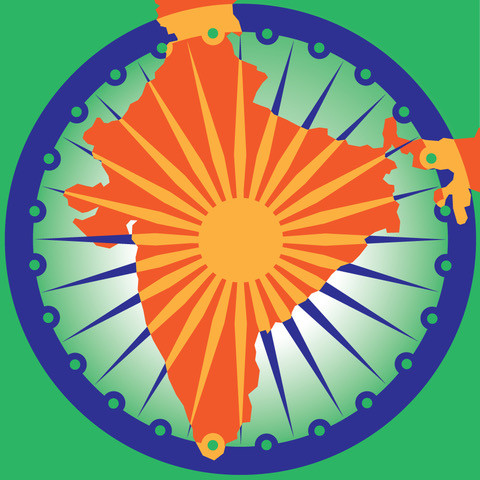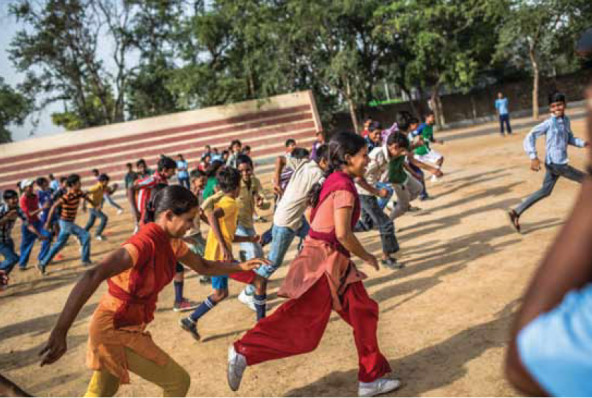
When UK-born Matthew Spacie moved to India in 1998 for his job as chief operating officer of Mumbai-based Cox & Kings, one of Asia’s largest travel groups, his days were busy. Shortly thereafter he cofounded Cleartrip, South Asia’s second largest online travel company, and his days were even busier. But he did make time to exercise. One day, when he was playing rugby at the exclusive Bombay Gymkhana, a members-only sports club, he decided to invite the teenage boys observing him through a mesh fence to play as well. They accepted immediately. For them, the experience of learning rugby and playing with Spacie was a welcome departure from their regular routines: smoking, using drugs, or wandering around Mumbai, hawking used clothes or wares at outdoor markets.
These teens were among Mumbai’s poorest, but the experiences they had playing rugby seemed to have a positive effect on their lives. Seeing that, Spacie decided to reach out to younger children living in the same slums, renting a bus and organizing weekend learning trips for them. He engaged the teenagers to help by acting as mentors to the younger children. The children named the vehicle the “Magic Bus” because it transported them to a place they considered magical. The teens were willing, motivated mentors.
Marveling at how such a small thing could have such a positive effect, Spacie decided to do more. His first thought was to find jobs for the older boys through his contacts in Mumbai. Within three months, however, all of them had quit or were fired from their new positions because none had the work ethic needed to stay employed. As Spacie said, he quickly realized that “You couldn’t just take an 18-year-old who had been living on the streets, or in the slums, put him in a work environment and expect him to succeed.”
 Children participating in one of Magic Bus’ more than 200 activity-based learning programs. (Photo by Daniel Berehulak, courtesy of Magic Bus)
Children participating in one of Magic Bus’ more than 200 activity-based learning programs. (Photo by Daniel Berehulak, courtesy of Magic Bus)
Spacie was not deterred by the failed experiment. Instead, it motivated him to devote his energies full-time to solving the problem of employability in India and to formalize Magic Bus into a nonprofit organization. He received seed funding from Dasra, a strategic philanthropy foundation in India. And with that support, he created a children’s development program that would use an activity-based curriculum to impart lessons about the importance of education, community and personal health and hygiene, gender equality, and nondiscrimination to children and their families. For example, in a two-hour activity session, children divide into two groups, with one called the “community” team and the other called the “problem” team. The problem team throws soccer balls in the way of the children in the community team, who are trying to reach the other end of the field, a metaphor for obstacles children face in going to school.
After the game, the children participate in a facilitated discussion about the importance of going to school, the obstacles they and their peers may face, and how the children attending school can share what they learn with peers who may not have that chance. This example is just one of the more than 200 games that Magic Bus uses to engage children. Each session represents a real-life situation and challenges so that children are able to relate them back to their daily lives.
The Silver Bullet
Magic Bus, formally launched in 1998, grew quickly in and around Mumbai. By 2007, it was serving some 4,500 young people. Its growth attracted the attention and support of philanthropies and other organizations, such as the World Bank and UNICEF, which awarded Magic Bus a $120,000 grant to extend its reach to 150,000 children. Pratik Kumar became the organization’s CEO. Drawing on his experience leading large development programs for the UN and the Indian government, Kumar developed a growth model focused on four tenets that Spacie calls “poverty kill areas”: empowerment around education, health, and gender rights; fair and democratic systems within the community; access to livelihoods and jobs; and employability skills that include work ethic, confidence, and emotional intelligence. Spacie calls the model the organization’s “Silver Bullet.” Here’s how it works: When Magic Bus enters a new neighborhood, staff members speak to the community, parents, local organizations, schools, and government officials to learn about the specific problems the community faces.
The staff members then seek assistance from the officials and community members, asking them to help identify young adults in their late teens or early 20s with the leadership potential to serve as mentors. Magic Bus provides these willing recruits with intensive training and ongoing feedback. When they are ready, the new mentors begin working with 20 to 30 children, volunteering between two and six hours per week and delivering the organization’s curriculum. (To ensure that children and communities view both genders in leadership roles, one young man and one young woman together mentor a group of 40 to 50 children.)
After six months, these mentors, known as Community Youth Leaders, receive certification and have an opportunity to participate in the Magic Bus Livelihood program. Participants in that program receive training in spoken English, computer skills, financial literacy, and effective workplace communication and behavior. Participants can also get training in specific industries, such as learning how to become a beautician, nursing assistant, or call center employee. Magic Bus then matches participants with employers. The 18-year-olds can also join Magic Bus as staff members.
Today, Magic Bus operates in 22 of India’s 29 states. It has an annual budget of about $6 million and a staff of about 1,000. It works with about 8,000 Community Youth leaders, who reach about 300,000 young people weekly. Ninety-three percent of the children enrolled in Magic Bus programs regularly attend school, and 98 percent of adolescent girls in the program are enrolled in secondary school, more than double the national average of girls enrolled in secondary school. To date, 85 percent of Magic Bus youth leaders are enrolled in the Magic Bus Livelihood program, and 71 percent go on to college, compared to 9 percent of the general population enrolled in college. Magic Bus’s interventions have helped to recast activity-based learning as a powerful development tool that can overcome some of India’s pressing development challenges.
Engaging Parents and the Community
Magic Bus also works hard to connect with the parents of participants and with the wider community. Staff and volunteer mentors meet regularly with community leaders and parents, updating parents about what the children have learned though the program and encouraging them to reinforce the messages at home. They offer support to parents who may receive criticism for sending their children to the program, introduce them to community members who can serve as allies, and work with other parents who may express reservations about enrolling their children, especially their daughters. And they inform and educate parents about career and education options available to their children. Magic Bus is able to keep costs in check by maintaining a lean management structure, relying on youth volunteers, and acting as an aggregator where possible, enabling and encouraging community members to access available nonprofit and government services. But the organization has also discovered that with the help of local donors, new Magic Bus locations can usually support themselves within three years. For example, a national office in Delhi or Mumbai may help seed fund the operations of a newer program in Chennai, but by the fourth year of operation, the program in Chennai should be able to sustain itself with local financial support.
Recently, four Magic Bus youths, whose ages ranged from 12 to 24, appeared on the Indian talk show Satyamev Jayate (Truth Alone Prevails). A television audience of several million had tuned in. The spotlight did not unnerve the young people as they sat on stage, answering questions from one of India’s most famous actors and TV personalities, Aamir Khan. The show’s theme was “A Ball Can Change the World.” One young woman, Parvati, recalled her first encounter with Magic Bus. It was literally a bus ride to a field, followed by games and another ride home. She said, “We did not want to leave to come back home. No one had treated us that well before.” Before participating in the program, Parvati had not attended school, instead spending her days playing at the Mumbai construction site where her parents worked, and managing household chores. Now she has not only completed school, but finished college as well, and she holds a full-time job as a trainer with Magic Bus. She is the first person in her extended family to finish college and have a job. When asked what Magic Bus had done for her, Pavarti replied that the organization had given her an identity.
Support SSIR’s coverage of cross-sector solutions to global challenges.
Help us further the reach of innovative ideas. Donate today.
Read more stories by Radhika Nayar.

